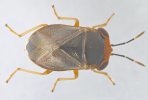Scientific name
Geocoris spp.
Taxonomic position
Hemiptera: Lygaeidae: Geocorinae
The subfamily Geocorinae, commonly known as big-eyed bugs, are at least partially predatory in habit and hence beneficial.
Diagnosis
- Body short and stout, oval, somewhat flattened, usually yellowish or brownish in colour
- Head transverse, with widely separated, prominent compound eyes; ocelli present
- Antennae four-segmented
- Rostrum or beak four-segmented
- Membrane of hemelytra with four or five simple veins
Images

 Adult, dorsal view Adult, dorsal view
Distribution
Cosmopolitan.
Biology / Hosts
Geocorids are mainly predatory on aphids, thrips, mites, scales, mealybugs, whiteflies, tingids and early instar lepidopterous larvae. Members of the genera Germalus and Geocoris,
particularly the latter, are commonly collected in agroecosystems. Adults are commonly seen running about on the ground or on foliage.
References
- Distant, W. L. 1902-1910. The Fauna of British India, Including Ceylon and Burma. Volumes I-V (V with appendix.). Taylor and Francis, London, England. Vol. 1: xxxviii +
438 (1902), 2: xvii + 503 (1904), 3: xvi + 503 (1906), 5: xii + 362 (1910).
- Mukhopadhyay, A. & Sannigrahi, S. 1993. Rearing success of a polyphagous predator Geocoris ochropterus (Hem.: Lygaeidae) on preserved ant pupae of Oecophylla smaragdina.
Entomophaga 38: 219-224.
- Slater, J.A. 1964. A Catalogue of the Lygaeidae of the world 1 & 2. University of Connecticut, Storrs, Conn.
- Sureshkumar, N. & Ananthakrishnan, T.N. 1985. Geocoris ochropterus Fabr. as a predator of some thrips. Proceedings of the Indian National Science Academy, B. Biological Sciences, 51: 2, 185-193.
|



